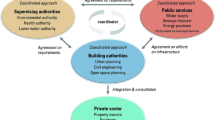Abstract
The development of the world population is characterized by an absolute population growth and a rapid urbanization. This process, taking place in Asia, Latin America, and Africa, poses major pressure on the affected urban regions. In Asian countries, this development is combined with high economic growth rates. At the same time, the climate change is proceeding, and the energy supply is going to become an existential problem. The rapidly growing cities therefore face the issue that the supply of infrastructures and public services lag behind the rapid urbanization. The increasing energy costs and the imperative to reduce the CO2 emissions aggravate the situation. The centralized systems which started to be implemented in the industrialized countries more than 100 years ago are no longer the appropriate way to solve these problems. The semicentralized integrated approach, recently developed for rapidly growing urban regions in China, in contrast, offers with its flexibility a sustainable solution to cope with these developments. This article presents objectives and first results of an interdisciplinary R&D project aiming at the adaptation of the semicentralized integrated approach to the case of Hanoi, the rapidly growing capital of Vietnam, to contribute to the solution of the sanitation problems of both the old City Center and the urban expansions in conjunction. This article focuses on the planning and institutional aspects. The technical questions will be presented later in separate articles. The ongoing project is conducted by the Technische Universität Darmstadt in cooperation with the National University of Civil Engineering Hanoi and an industrial partner.








Similar content being viewed by others
References
Bieker S, Cornel P (2009) Semicentralized supply and treatment systems, integrated infrastructure solutions for urban areas of tomorrow. In: Conference proceeding of the R’09 Twin World Congress, Nagoya, 14 Sept 2009
Bieker S, Schramm S (2010) Urban semicentralized supply and disposal innovations and challenges for Hanoi, Vietnam. Int J Sustain Dev 13(1/2):97–110
Bieker S, Schramm S, Wagner M, Cornel P (2008) Semicentralized supply and treatment systems—solutions for fast growing urban areas, Hanoi 2008. In: Proceeding of IWA conference on sanitation options in the Asia Pacific, Hanoi, pp 1–10
Bieker S, Cornel P, Wagner M (2010) Semicentralised supply and treatment systems: integrated infrastructure solutions for fast growing urban areas. Water Sci Technol 61(11):2905–2913
Böhm HR, Bieker S, Selz A (2006) Semi-centralized infrastructure systems: integrated systems for a sustainable development of fast growing urban areas. In: Conference proceeding of the 12th annual international sustainable development research conference, University of Hong Kong, ISBN 978-962-7589-27-3
Čuček L, Lam HL, Klemeš J, Varbanov PS, Kravanja Z (2010) Synthesis of regional networks for the supply of energy and bioproducts. Clean Technol Environ Policy 12(6):635–645
Di Gregorio M, Trinh Thi T, Nguyen Thy HL, Nguyen Thu H (1998) Linking community and small enterprise activities with urban waste management: Hanoi case study, Urban Waste Expertise Programme (1998), pp. 1–74. WASTE, Gouda
Leaf M (2002) A tale of two villages. Cities 19(1):23–31
Mitchell CL (2008) Altered landscapes, altered livelihoods: the shifting experience of informal waste collecting during Hanoi’s urban transition. Geoforum 39:2019–2029
Mitchell CL (2009) Trading trash in the transition: economic restructuring, urban spatial transformation, and the boom and bust of Hanoi’s informal waste trade. Environ Plan A 41:2633–2650
Schramm S (2011) Semicentralized water supply and treatment—options for the dynamic urban region of Hanoi, Vietnam. Paper accepted at Journal of Environmental Assessment Policy and Management
Viet Anh N, Nga PH, Nhue TH, Morel A (2005) The potential for decentralized wastewater management for sustainable development. In: Water environmental federation (WEF) conference, San Francisco, pp 1–27
Vietnam Ministry of Construction (MOC) (1999) Strategy of solid waste management in urban areas and industrial zones in Vietnam by the year 2020, Hanoi
Waibel M (2006) The production of urban space in Vietnam’s metropolis in the course of transition: internalization, polarization and newly emerging lifestyles in Vietnamese society, Trialog, Journal for planning and building in the Third World, Darmstadt
Acknowledgments
This article is based on R&D projects conducted by the Institute IWAR, Technische Universität Darmstadt in cooperation with the Tongji University Shanghai, the Qingdao Technological University, the National University of Civil Engineering Hanoi and industrial partners since 2005. They are funded by the German Federal Ministry for Education and Research (BMBF), the Chinese Ministry of Science and Technology, and Vietnamese Ministry of Construction.
Author information
Authors and Affiliations
Corresponding author
Rights and permissions
About this article
Cite this article
Böhm, H.R., Schramm, S., Bieker, S. et al. The semicentralized approach to integrated water supply and treatment of solid waste and wastewater—a flexible infrastructure strategy for rapidly growing urban regions: the case of Hanoi/Vietnam. Clean Techn Environ Policy 13, 617–623 (2011). https://doi.org/10.1007/s10098-011-0378-9
Received:
Accepted:
Published:
Issue Date:
DOI: https://doi.org/10.1007/s10098-011-0378-9




